Smarter Balanced CAT Script
Scripts that provide instructions for a TA to read to students during test administration are as follows:
The DFAs for the CAAs for ELA and mathematics and the embedded performance tasks for the CAA for Science, which include directions, can be downloaded from the password-protected TOMS.
TA Tasks Before Testing
Before administering a test session, the TA should verify that the following tasks have been completed:
- Verify the security of the testing environment prior to beginning a test session. (Refer to the subsection Security of the Test Environment.)
- Arrange student seats so that students cannot view each other’s answers.
- Cover or take down all displayed instructional materials (e.g., vocabulary charts, periodic tables, etc.).
- Post “TESTING—DO NOT DISTURB” signs outside of the testing room.
- Ensure that students do not have access to digital, electronic, or manual devices (e.g., cell phones, smart watches) during testing unless it is an approved medical support. Hang “Unauthorized Electronic Devices May Not Be Used at Any Time During the Testing Session” signs where clearly visible to students in the testing environment as a test security reminder.
- Verify that students have access to and use of the additional required resources specific to each assessment and content area (e.g., scratch paper for all tests, headphones for ELA, graph paper for mathematics grades six and above). Refer to the subsection Additional Required Resources for a complete list.
- Recommended: Launch secure browsers on all testing devices before students sit down to test.
To ensure that all students are tested under the same conditions, the TA should adhere strictly to the administration script for a particular assessment unless a student is assigned the non-embedded designated support for simplified test directions. The readable script can be found in the shaded boxes in the Directions for Administration topic for a particular assessment. When asked, the TA should answer questions raised by students but should never help the class or individual students with specific test items. No test items can be read to any student for any content area, unless the student is assigned a read-aloud non-embedded designated support or accommodation as listed in the California Assessment Accessibility Resources Matrix..
If the class is resuming a test and the TA is sure that all students are able to log on without hearing the logon directions again, the TA may skip the italicized portions of the directions.
All directions that a TA needs to read to students are indicated by the word “SAY” and are in boxes so they stand out from the regular text. They should be read exactly as they are written, using a natural tone and manner (except for students assigned the simplified test directions non-embedded designated support). If the TA makes a mistake in reading a direction, the TA should stop and say, “I made a mistake. Listen again.” Then the direction should be reread.
Before each test begins, the TA should encourage students to do their best.
Administer an Online Test Session
Each assessment is displayed in the Test Administrator Interface using a differently colored background, as follows:
Computer-based Assessments:
- Green—all interim Assessments
- Red—Smarter Balanced Summative Assessments
- Indigo—California Alternate Assessments (CAA)
- Brown—California Science Test (CAST)
- Mint—California Spanish Assessment (CSA)
- Teal—Initial ELPAC
- Blue—Summative ELPAC
- Orange—Alternate ELPAC
- Purple—Initial Alternate ELPAC
Online Practice and Training Tests:
- Golden Yellow—all training tests
- Pink—all practice tests
A test session must be created before students can log on to the secure student browser. For a student to take a specific test, the test must be included in the test session.
If a TA has mistakenly selected and administered the summative assessment when intending to administer an interim assessment or practice or training test, the TA should stop the test and notify the testing coordinator. The LEA CAASPP coordinator or CAASPP test site coordinator will need to report the incident using the CAASPP STAIRS/Appeals process. However, while all cases of accidental summative should be filed, not all cases will be eligible for a Reset Appeal.
Open the Test Administrator Interface and Approve Students for Testing—All Assessments
The TA must create a test session before students can log on to the Student Testing Site. For a student to take a specific test, it must be included in the test session.
This section contains information on how to start a test session, add tests to the session, verify students’ test settings, approve students for testing, and monitor their progress.
Beginning a Smarter Balanced CAT Assessment
Follow these instructions to administer the computer-based Smarter Balanced CAT assessments unless a student is assigned the non-embedded designated support for Simplified Test Directions. The TA must create a test session before students can log on to the Student Testing System (but no more than 30 minutes prior or the system will time out). When a TA creates a test session, a unique session ID is randomly generated. This session ID must be provided to the students before they log on and should be written down.
The process for administering computer-based tests is as follows:
- The TA selects tests and starts a test session in the Test Administrator Interface.
- Students sign in and request approval for tests.
- The TA reviews students’ requests and approves them for testing.
- Students complete and submit their tests.
- The TA stops the test session and logs off.
For information about the testing process from a student’s perspective, refer to the subsections Signing In to the Student Testing Site and Features of the Student Testing Application.
- Test Administrator
Navigate to the CAASPP website on a web browser. -
Test Administrator
Select the [Test Administrator Interface for All Online Tests] button, as shown in figure 1.
Figure 1. [Test Administrator Interface for All Online Tests] button
-
Test Administrator
Log on to the Test Administrator Interface using the TA’s sign-in credentials, as shown in figure 2.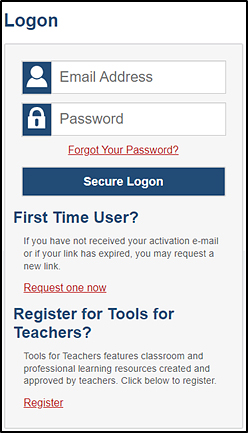
Figure 2. Test Administrator Interface Logon screen
-
Test Administrator
Once logged on to the Test Administrator Interface, the [Active Sessions] tab will appear. Select the [Join] button in the Action column (figure 3) to join a previously scheduled session, or select the [Start a New Session Now] button (figure 4) to start a new session.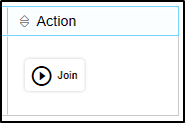
Figure 3. [Join] button in the Test Administrator Interface
-
Test Administrator
Select the [Start a New Session Now] button (figure 4); this appears on the right side of the screen.
Figure 4. [Start a New Session Now] button
-
Test Administrator
If the TA is associated with multiple schools, an “Important!” message appears after selecting the [Start a New Session Now] button. The TA must select the appropriate school from the Select your School/District drop-down list in this message and select the [Go] button, as shown in figure 5. The TA may only select one school or district at a time. Students who have the session ID and are enrolled in a different school than the one the TA selected will also be able to test in the same test session as students in other schools, if the TA has roles in multiple schools. To select a different school or district, the TA must log off and then log back on. Regardless of their test site, students who are testing in person should be supervised at all times.
Figure 5. Important! message from the Test Administrator Interface
-
Test Administrator
The Operational Test Selection screen, as shown in figure 6, color-codes tests and groups them into various categories. A test group, such as “Smarter Balanced Summative Assessments,” may include one or more subgroups. All test groups and subgroups appear collapsed by default.
Figure 6. Operational Test Selection screen
- Test Administrator
To select a test or tests for the session, use one of the following on-screen icons; these are indicated in figure 7:- To expand a collapsed test group, select the [Plus] plus-sign [
 ] icon.
] icon. - To collapse a test group, select the [Minus] minus-sign [
 ] icon.
] icon. - To expand the list of all tests, select the [Expand All] outward arrows [
 ] icon.
] icon. - To select individual tests, mark the checkbox for each test to be included.
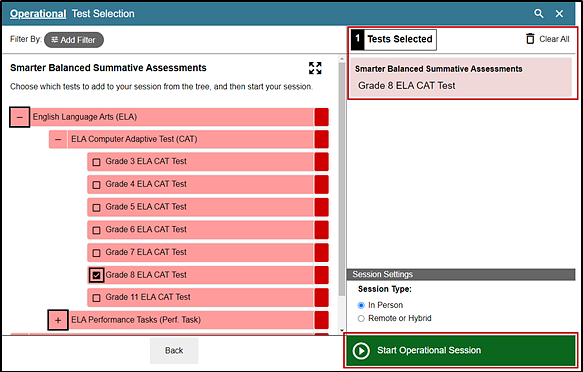
Figure 7. Selected tests in the Operational Test Selection screen
- To expand a collapsed test group, select the [Plus] plus-sign [
- Test Administrator
Either use the filtering feature to open specific grade-level or content-area assessments; or, to start the test, select the [Start Operational Session] button. These features are indicated in figure 8. Take the following steps to use the filtering feature:- Select the [Add Filter] button [
 ]to access the filter panel.
]to access the filter panel. -
Expand the available filter categories by selecting a [Plus] plus-sign [
 ] icon.
] icon.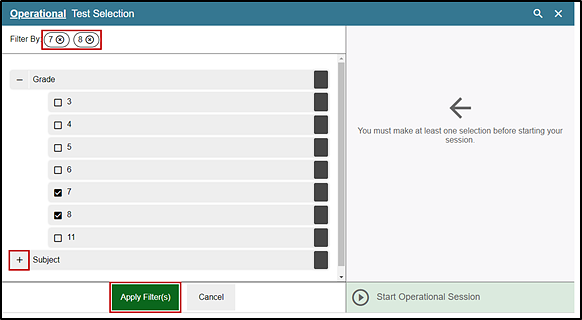
Figure 8. Sample Operational Test Selection screen with filtering option
- Select the criteria to filter. For example, to select all the tests in a content area, mark the checkbox for that group.
- Select the [Apply Filter(s)] button [
 ] (indicated in figure 8).
] (indicated in figure 8). - Remove the filter by selecting the [Remove Filter] “X” icon [
 ] (indicated in figure 8).
] (indicated in figure 8). - Select the [Start Operational Session] button to start the test (indicated in figure 9).

Figure 9. Sample Operational Test Selection screen with filtering applied
- Select the [Add Filter] button [
-
Test Administrator
Because the TA is administering a Smarter Balanced assessment, there will be a warning letting the TA know that a summative assessment is about to be administered. If the TA selects [OK], as shown in figure 10, the TA can either continue with the test administration or exit from the Test Administrator Interface if the user selected a summative assessment unintentionally.
Figure 10. Summative Assessment confirmation box
-
Test Administrator
Inform students of the test session ID. The session ID is automatically generated upon selecting [Start Operational Session]. Write the session ID in a place where all students can clearly refer to it during group administrations. The current session ID also appears on the Test Administrator Interface screen saver when the screen saver is active. A sample of a session ID is shown in figure 11.
Figure 11. Sample session ID at the top of the Test Administrator Interface
-
Test Administrator
Read the following SAY statement.SAY:
Today, you will take the [Smarter Balanced—insert grade, ELA/mathematics] test. You will be given a test session ID that is required to start the test. Before logging on, let’s go over some test rules.
You must answer each question on the screen before selecting NEXT. If you are unsure of an answer, provide what you think is the best answer. If you would like to review that answer at a later time, mark the question for review before going on to the next question. You may go back and change the answer during this test session.
You may pause at any point in the test by selecting PAUSE rather than NEXT after answering a question. Please raise your hand if you need a break and ask permission before selecting PAUSE.
If you pause your test for more than 20 minutes, you will not be able to go back and change your answers to any questions, even the ones you marked for review. You may check your answers to any questions before you pause your test.
-
Test Administrator
Read the following SAY statement for the mathematics CAT in grades six through eleven only.SAY:
This test is divided into segments. When you get to the end of a segment, you will be told to review your answers before moving on. Once you submit your answers and move on to the next segment, you will not be able to return to any of the questions in the previous segment.
-
Test Administrator
Read the following SAY statement and all subsequent SAY statements to everyone.SAY:
Your answers need to be your own work. Please keep your eyes on your own test and remember, there should be no talking. If you have a cell phone, smartwatch, or other nonapproved electronic devices, please turn off the device and put it away.
If you finish your test early, please sit quietly.
- Test Administrator
Logon tickets may be provided to each student. The logon tickets should provide the students’ SSID. Note that logon tickets are secure testing materials and should be securely destroyed after testing. -
Student
Log on to the Student Testing Site through the secure browser. -
Test Administrator
Direct students to sign in using the Student Sign-In screen. It is not necessary to read any italicized, asterisked sentences to students testing over multiple days who have already heard these instructions at least once.SAY:
Now we are ready to log on. Once you have logged on, you will have to wait for me to approve the test before you start. I’ll be checking that you have correctly entered the test session ID and other information.
Enter your first name and SSID number, as listed on your logon ticket. Then enter the test session ID. *Raise your hand if you need help typing this information on your keyboard.
-
Student
Sign in using the Student Sign-In screen, as shown in figure 12.
Figure 12. Student Sign In screen
-
Test Administrator
Ensure that all students have successfully entered their information. If a student is unable to log on, the student will be prompted to try again and provided with a message describing the reason. If the student is still having difficulty, the student should indicate to the TA what is incorrect; a TA may assist students with logging on, if necessary. The TA can look up the correct information using the Student Lookup function on the TA Interface or in TOMS. If the issue cannot be resolved, the TA should tell the student to select [No] to end the logon process and then contact the CAASPP test site coordinator to determine the next steps.SAY:
Now select SIGN IN. Once you have successfully logged on, you will see a screen with your first name and other information about you. If all of the information on your screen is correct, select YES to continue. If any of the information is incorrect, please raise your hand and show me what is incorrect.
-
Student
Verify identity by selecting [No] or [Yes], as shown in figure 13.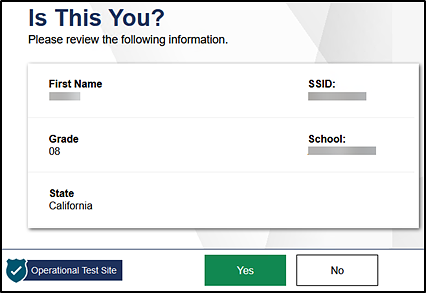
Figure 13. Is This You? screen
-
Test Administrator
Inform students of the test type (ELA or mathematics CAT) in which they are participating today.SAY:
On the next screen, select the [INSERT NAME OF TEST (e.g., ELA Grade 4 CAT)], and then select START TEST. After you have selected your test, you will see a screen with a moving bar and message saying that you are waiting for test administrator approval. Please wait quietly while I check and approve each of your tests.
Only the tests that the TA selected for the test session for which students are eligible are selectable by students. Because students may be able to select from more than one test—for example, a PT and a CAT in both ELA and mathematics—the TA should direct students to select the appropriate test name based on the intended assessment (ELA or mathematics) and type, which is CAT. The TA should contact the CAASPP test site coordinator if unsure of the content area or assessment that is being administered.
The sample shown in figure 14 is from the practice and training test interface.
-
Student
Select the test to take, as shown in figure 14.
Figure 14. Your Tests selection screen
-
Student
Wait for the TA’s approval, as shown in figure 15.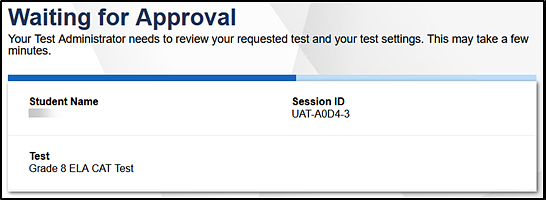
Figure 15. Waiting for Approval screen
-
Test Administrator
Approve students to test by selecting the [Approve] check mark [ ] icon in the Actions column for individual students or the [Approve All Students] button, as indicated in figure 16, for each group of tests. Select the [View] eye [
] icon in the Actions column for individual students or the [Approve All Students] button, as indicated in figure 16, for each group of tests. Select the [View] eye [ ] icon, also in figure 16, to view the student’s settings for the current test. (For example, if the student had been assigned the designated support to turn off any universal tool(s), the TA can toggle the universal tools on and off.) “Custom” in the See Details column indicates the student has been assigned test settings. Refer to the Types of Resources subsection of the CAASPP and ELPAC Accessibility Guide for the accessibility resources—both embedded and non-embedded—that are available for the CAASPP.
] icon, also in figure 16, to view the student’s settings for the current test. (For example, if the student had been assigned the designated support to turn off any universal tool(s), the TA can toggle the universal tools on and off.) “Custom” in the See Details column indicates the student has been assigned test settings. Refer to the Types of Resources subsection of the CAASPP and ELPAC Accessibility Guide for the accessibility resources—both embedded and non-embedded—that are available for the CAASPP.If a student’s test settings are incorrect, deny the student; the TA should contact the LEA CAASPP coordinator or CAASPP test site coordinator to correct the test settings in TOMS and test the student on another day. Ensuring the test settings are correct before the student begins testing is critical to avoid the need for a test reset that may result in additional testing for the student later.
The TA should also ensure that students selected the correct assessment; students who are awaiting approval for an incorrect assessment should be denied approval. These students should log on again and select the correct test. It is very important that the TA pays close attention to the test name prior to approval to be sure it is the correct test to be administered at that time.

Figure 16. Approvals and Student Test Settings screen
-
Test Administrator
Have students run the sound and video checks. All students will have the sound and video playback check. Only students who are using the text-to-speech resource also have the text-to-speech sound check. Only students who are using the speech-to-text resource have the recording device check.SAY:
Next you should see a screen that prompts you to check that the sound and video on your computer are working. Put your headsets on and select the triangle PLAY button. If you hear the music and see the moving musical notes, select the [I could play the video and sound] button. If not, raise your hand.
-
Student
If beginning a test that has listening items, complete the audio and video checks with headphones. Test with the listening items audio and video check, as shown in figure 17.
Figure 17. Sound and Video Playback Check page
-
Test Administrator (only for students taking any assessment using the text-to-speech resource)
SAY:
Next you should see a screen that prompts you to check that the sound on your computer is working. Put your headsets on and select the icon of the speaker in the circle to hear the voice. If you hear the voice, select [I heard the voice]. If not, raise your hand.
-
Student
If assigned text-to-speech, complete the audio checks with headphones. Test with text-to-speech audio check, as shown in figure 18.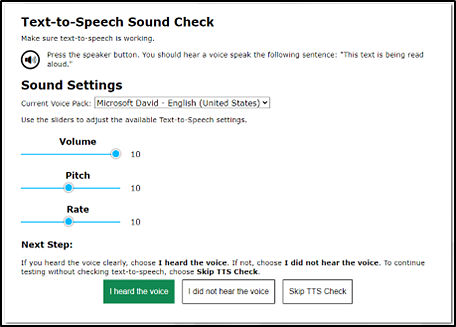
Figure 18. Text-to-Speech Sound Check screen
-
Test Administrator (only for students taking any assessment using the speech-to-text resource)
SAY:
You should see a screen that prompts you to check that your recording device is working. Put your headsets on and select the icon of the microphone in a circle to record the sound. Follow the rest of the instructions on the screen to record your voice and then listen to your recording. If you hear your voice, select [I heard my recording]. If not, raise your hand.
-
Student
If assigned speech-to-text, complete the recording device check with headphones. Test with the recording device check, as shown in figure 19.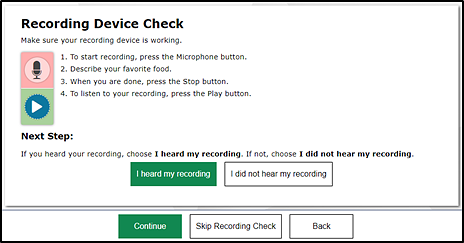
Figure 19. Recording Device Check screen
-
Test Administrator
If audio issues occur, do the following:- Ensure headphones are securely plugged in to the correct jack or USB port.
- If the headphones have a volume control, ensure the volume is not muted.
- Ensure that the audio on the device is not muted (often via a control panel or settings window).
- If the student is still experiencing issues, contact the CAASPP test site coordinator or school technology coordinator.
-
Test Administrator
Tell students how to take the test.SAY:
Before your test appears, you will see a tutorial page listing the test tools and buttons that you may use during the test or that will appear on the test. You can also find this information during your test by selecting the HELP button.
When you are ready to begin your test, select BEGIN TEST NOW at the bottom of the page.
-
Student
Select [Begin Test Now], as shown in figure 20, to begin testing.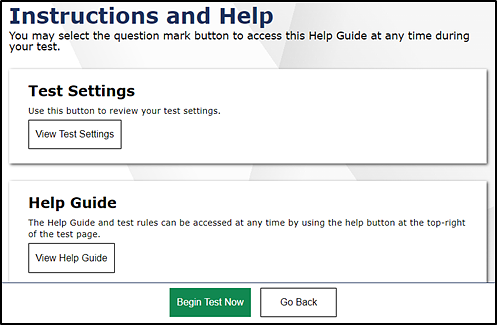
Figure 20. Instructions and Help screen
- Test Administrator
Continue with the instructions in the next subsections, Monitoring Student Progress and Ending a Test Session.
Monitoring Student Progress
Test Selection
Test Administrator
It is very important that TAs monitor student progress throughout the test session. This includes verifying that students are participating in the CAT for the appropriate content area.
The TA monitors the test each student is taking by referring to the Tests table in the Test Administrator Interface, shown in figure 21. Note that the list of student names can be sorted by column headings. This site will not show test items or scores but will show the TA the percentage of items that have been delivered to the student.
In the event a student is taking an incorrect test, the TA should pause the student’s test. The TA should then instruct the student to log off and log on again to select the correct test. The Test column is called out in figure 21.
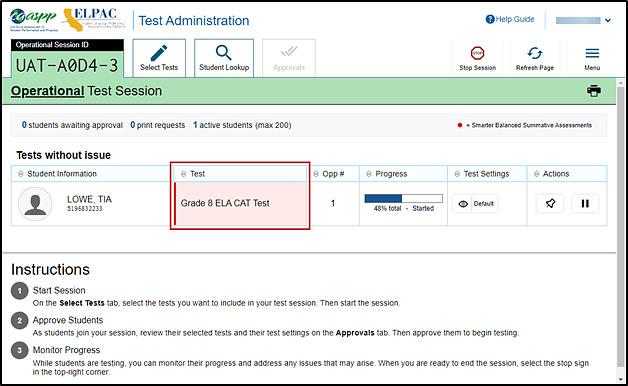
Figure 21. Monitoring student progress in the Test Administrator Interface
In the rare event that a student starts a test unintentionally (for example, if the student selected a PT instead of a CAT, or selected mathematics instead of ELA), the test’s expiration timeline will be activated. If a student is unable to return to and complete the test before it expires in 15 days (PT) or 45 days, the CAASPP test site coordinator or LEA CAASPP coordinator must use the STAIRS/Appeals process to report the incident and submit an Appeal to reopen the test.
Test Security
Once students have started the Smarter Balanced assessment, the TA should monitor the room to ensure that all conditions of test security are maintained. If the TA witnesses or suspects the possibility of a test security incident, the TA should contact the CAASPP test site coordinator, the LEA CAASPP coordinator, or both of these coordinators immediately in accordance with the security guidance provided in this manual.
Student Directions During Testing
While the Test Administrator Interface is designed to refresh automatically every minute, the TA can refresh it manually at any time by selecting the [Refresh Page] button at the top right corner of the page.
If the TA notices that a student is off task, the TA may say the following statement to the student, verbatim, to keep the student focused.
SAY:
It is important that you do your best. Do you need to pause the test and take a break?
If a student is concerned about an item, direct the student to review a tutorial by reading the following script verbatim.
SAY:
Try your best and choose the answer that makes the most sense to you. If you are unsure about how a question works, you can review a tutorial by selecting the “tutorial” option from the context menu.
Content Applicable Only to Students in Grade Eleven Taking Smarter Balanced Summative Assessments
Students in grade eleven taking a CAT will get an additional question at the end of their test sessions for both ELA and mathematics, such as is shown in figure 22. This question appears where students are reminded of any test questions flagged for review.

Figure 22. Sample EAP question for the CAASPP Smarter Balanced for ELA
This question is not part of the assessment, but is presented to allow students the option of selecting whether they will share their scores on the CAASPP Smarter Balanced Summative Assessments with the CSU system as part of the EAP. Please read the text in the next box if administering a test to students in grade eleven. Otherwise, skip the text in that box and continue with the test administration.
Students must answer this question after each of the content-area assessments to have the results of that test reported to the CSU. Agreeing to release the results of one content-area assessment to the EAP is not agreement to release the results of the other content-area assessment; the student must agree individually to both to have both sets of results reported to the EAP. Sending results to the CSU does not impact admission decisions.
EAP SECTION—TO BE READ TO STUDENTS IN GRADE ELEVEN ONLY
Test Administrator
Read the following SAY statement.
SAY:
The Early Assessment Program (EAP) will assist the California State University (CSU) system in providing you information on your readiness for college-level written communication and mathematics/quantitative reasoning prior to starting your senior year. The results are used to determine your placement in appropriate coursework once you have been admitted. The release of CAASPP results will not affect your application for admission.
Please carefully read the statement presented as the last question in this test session. If you do not wish your results to be sent to the CSU, select “Do Not Release.” If you are considering or plan to enroll at CSU, select “Release” and then select the [Submit Test] button. Your Smarter Balanced results for this test will be provided by selecting the Release circle and then submitting. If you do not select to release your results, you may be requested to provide a copy of your results to the institution at a later time. Even if you have already answered this question at the end of an ELA or mathematics test you have already taken, you need to answer it for this test to have the EAP results of both tests reported.
Your CAASPP Student Score Report will provide a website, where additional information is available on what your EAP results mean.
END OF EAP SECTION
Ending a Test Session
-
Test Administrator
When there are approximately 10 minutes left in the test session, the TA should give students a brief warning.SAY:
We are nearing the end of this test session. Please review your answers, including any questions you marked for review now. Do not submit your test unless you have answered all of the questions.
-
Test Administrator
The following should be read for the ELA CAT portion only.SAY:
If you are working on a set of questions for a reading passage, please finish all of the questions in that set.
SAY:
If you need additional time let me know.
Submitting Tests
-
Test Administrator
After answering the last item in each segment, each student is presented with a screen prompting the student to review answers within that segment of the test prior to submitting. The Mark for Review function is provided as a reminder to the student that the student had a question or concern about a particular item. However, a student cannot return to items in segments that have been submitted.After answering the last question, students must submit their tests. If students would like to review their answers before submitting their test, they should select an item number to review and then [SUBMIT TEST] after they finish reviewing all desired items. Once a student selects [SUBMIT TEST], the student will not be able to review answers.
-
Test Administrator
Read the following SAY statement.SAY:
This test session is now over. If you have not finished, select PAUSE, and you will be able to finish at another session.
-
Test Administrator
Read the following SAY statement only if the length of time pausing the test is greater than 20 minutes, e.g., the student will continue testing on another day.SAY:
Remember, if you are not finished and need to pause your test for more than 20 minutes, you will not be able to go back to the questions from this test session, including questions marked for review. You will also not have access to the notes you entered in the Digital Notepad.
SAY:
If you have answered all the questions on your test and have finished reviewing your answers, select SUBMIT TEST. I will now collect any scratch paper or other materials.
TAs should select [Stop Session] to end the test session; when selected, the Important! message box appears (figure 23). However, ending the test session will pause any student test in the session that is still in progress.

Figure 23. Important! message box
When finished, TAs can log off the Test Administrator Interface by selecting the [Name] drop-down list at the top right and then selecting Logout. TAs should also collect any scratch paper (and graph paper for mathematics in grades six and up) and follow procedures for local secure destruction as outlined in the Handling Secure Materials section.
Logging Off
Test Administrator
Use caution when logging off the Test Administrator Interface, as this will log off other related systems (for example, TOMS). To log off the Test Administrator Interface, select the [Name] drop-down list in the top-right corner of the screen, and then select Logout (shown in figure 24).
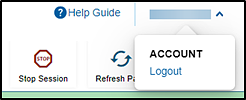
Figure 24. Logout option under the [Name] drop-down list
Once the Test Administrator Interface is closed, the TA will not be able to resume the test session and will need to create a new test session to continue testing.
Resolve Test Administrator Interface Issues During Testing
When summative assessments are not displayed in the Test Administrator Interface, it may be that a TA has not signed the Test Security Affidavit in TOMS prior to logging on to the Test Administrator Interface. Once signed, the TA will be allowed access to view and administer the CAASPP assessments.
Other causes might include a dropped internet connection, incorrect web browser version, or other unique situations. These must be resolved before testing can begin.

